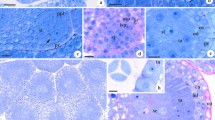Abstract
The polyandrous androecium ofCaloncoba echinata (Oliv.)Gilg initially consists of a flat, ring-like mound. On it stamen primordia arise almost simultaneously and in somewhat irregular (neither clearly centrifugal nor centripetal) sequence. This fits the development reported for other members of theGuttiferales-Violales group. The anther loculi are transversely septate as in someAnnonaceae and a few other Angiosperm families. This character does not appear to be phylogenetically primitive.
Similar content being viewed by others
Literaturverzeichnis
Boke, N. H., 1963: Anatomy and development of the flower and fruit ofPereskia pititache. Amer. J. Bot.50, 843–858.
Corner, E. J. H., 1946: Centrifugal stamens. J. Arn. Arb.27, 423–437.
Corti, R., 1948: Sul dioicismo diIdesia polycarpa. N. Giorn. Bot. Ital.55, 446–495.
Cronquist, A., 1957: Outline of a new system of families and orders of Dicotyledons. Bull. Jard. Bot. Brux.27, 13–40.
Eckardt, Th., 1971: Anlegung und Entwicklung der Blüten vonGyrostemon ramulosus Desf. Bot. Jahrb. Syst.90, 434–446.
Ernst, A., undSchmid, E., 1913: Über Blüte und Frucht vonRafflesia. Morphologisch-biologische Beobachtungen und entwicklungsgeschichtlich-zytologische Untersuchungen. Ann. Jard. Bot. Buitenzorg, Sér. 2,12, 1–58.
Gilg, E., 1925:Flacourtiaceae. In:Engler, A., undPrantl, K.: Die natürlichen Pflanzenfamilien21, 377–457, 2. Aufl., Leipzig: W. Engelmann.
Gopinath, D. M., 1946: Development of the female gametophyte inFlacourtia cataphracta andF. ramontchii. Proc. Ind. Sci. Congr.33 (3), 109.
Guédès, M., 1966: Stamen, carpel and ovule. The teratological approach to their interpretation. Adv. Front. Pl. Sci.14, 43–108.
- 1972: Contribution à la morphologie du phyllome. Mém. Mus. Hist. Nat. (Paris), n. S., B,21, 179 pp.
Heel, W. A. van, 1966: Morphology of the androecium inMalvales. Blumea13, 177–394.
—, 1973: Flowers and fruits inFlacourtiaceae. I.Scaphocalyx spathacea Ridl. Blumea21, 259–279.
Heslop-Harrison, J., 1972: Sexuality of Angiosperms. In:Steward, F. C. (ed.): Plant physiology. A treatise. VI C: Physiology of development: From seeds to sexuality, 133–289. New York-London: Academic Press.
Hiepko, P., 1965: Das zentrifugale Androeceum derPaeoniaceae. Ber. Dtsch. Bot. Ges.77, 427–435.
Hummel, K., undStaesche, Karin, 1962: Die Verbreitung der Haartypen in den natürlichen Verwandtschaftsgruppen. In:Zimmermann, W., undOzenda, P. G. (Hrsg.): Handbuch der Pflanzenanatomie IV, 5, 207–292. Berlin-Nikolassee: Gebr. Borntraeger.
Johri, B. M., andBhatnagar, S. P., 1972:Loranthaceae. Bot. Monogr.8. New Delhi: Council Sci. Industr. Res.
Juliano, J. B., 1935: Morphological contribution on the genusAnona Linnaeus. Philippine Agricult.24, 528–541.
Keating, R. C., 1973: Pollen morphology and relationships of theFlacourtiaceae. Ann. Mo. Bot. Gard.60, 273–305.
Kubitzki, K., 1973: Probleme der Großsystematik der Blütenpflanzen. Ber. Dtsch. Bot. Ges.85, 259–277.
Kuijt, J., 1969: The biology of parasitic flowering plants. Berkeley-Los Angeles: Univ. Calif. Press.
Leins, P., 1964a: Die frühe Blütenentwicklung vonHypericum hookerianum Wight andArn. undH. aegypticum L. Ber. Dtsch. Bot. Ges.77, 112–123.
—, 1964b: Das zentripetale und zentrifugale Androeceum. Ber. Dtsch. Bot. Ges.77, (22)-(26).
—, 1971: Das Androeceum der Dikotylen. Ber. Dtsch. Bot. Ges.84, 191–193.
—, undWinhard, P., 1973: Entwicklungsgeschichtliche Studien an Loasaceen-Blüten. Österr. Bot. Z.122, 145–165.
Lersten, N. R., 1971: A review of septate microsporangia in vascular plants. Iowa State J. Sci.45, 487–497.
Mauritzon, J., 1936: Zur Embryologie einigerParietales-Familien. Sv. Bot. Tidskr.30, 79–113.
Melchior, H., 1964:Guttiferales/Violales. In:Engler, A.: Syllabus der Pflanzenfamilien2, 156–175/322–341. 12. Aufl. Berlin-Nikolassee: Gebr. Borntraeger.
Merxmüller, H., 1972: Systematic botany—an unachieved synthesis. Biol. J. Linn. Soc.4, 311–321.
—, undLeins, P., 1971: Zur Entwicklungsgeschichte männlicher Begonienblüten. Flora160, 333–339.
Narayana, R., 1955: Morphological and embryological studies in the familyLoranthaceae-Loranthoideae. Ph. D. Thesis, Univ. Delhi.
Narayanaswami, S., andSawhney, S., 1959: Microsporogenesis and embryo sac development inCasearia tomentosa Roxb. Phyton (B. Aires)13, 133–144.
Pax, F., 1889:Myrsinaceae. In:Engler, A., undPrantl, K.: Die natürlichen Pflanzenfamilien IV 1, 84–97. Leipzig: W. Engelmann.
Periasamy, K., andSwamy, B. G. L., 1960: Studies in theAnnonaceae.—I. Microsporogenesis inCananga odorata andMiliusa wightiana. Phytomorphology9, 251–263.
Rauch, K. von, 1936: Cytologisch-embryologische Untersuchungen anScurrula atropurpurea Dans. undDendrophthoe pentandra Miq. Ber. Schweiz. Bot. Ges.45, 5–61.
Rohweder, O., 1972: Das Andröcium derMalvales und der „Konservatismus“ des Leitgewebes. Bot. Jahrb. Syst.92, 155–167.
Sattler, R., 1973: Organogenesis of flowers. A photographic text-atlas. Toronto-Buffalo: Univ. of Toronto Press.
Schaeffer, J., 1972: Pollen morphology of the genusHydnocarpus (Flacourtiaceae) with notes on related genera. Blumea20, 65–87.
Schaeppi, H., undSteindl, F., 1942: Blütenmorphologische und embryologische Untersuchungen an Loranthoideen. Vierteljahrsschr. Naturf. Ges. Zürich87, 301–372.
- 1945: Blütenmorphologische und embryologische Untersuchungen an einigen Viscoideen. Vierteljahrsschr. Naturf. Ges. Zürich90, Beih. 1.
Sleumer, H., 1974: Revision der GattungCaloncoba Gilg (Flacourtiaceae). Bot. Jahrb. Syst.94, 120–138.
Takhtajan, A., 1973: Evolution und Ausbreitung der Blütenpflanzen. Stuttgart: G. Fischer.
Tamura, M., 1972: Morphology and phyletic relationships of theGlaucidiaceae. Bot. Mag. (Tokyo)85, 29–41.
Tohda, H., 1971: Embryological study onIdesia polycarpa. Sci. Rep. Tôhoku Univ., IV,35, 231–237.
Troll, W., 1965: Kommission für Biologische Forschung. Botanischer Teil. Akad. Wiss. Lit. Mainz, Jahrb.1965, 110–131.
—, 1969: Kommission für Biologische Forschung. Botanischer Teil. Akad. Wiss. Lit. Mainz, Jahrb.1969, 82–95.
Tucker, Shirley C., 1960: Ontogeny of the floral apex ofMichelia fuscata. Amer. J. Bot.47, 266–277.
Ventura, Maria, 1938: Osservazioni embriologiche suArechavaletaia uruguayensis Speg. Ann. Bot. (Roma)21, 527–533.
Vestal, P. A., 1938: The significance of comparative anatomy in establishing the relationship of theHypericaceae to theGuttiferae and their allies. Philippine J. Sci.64, 199–256.
Author information
Authors and Affiliations
Rights and permissions
About this article
Cite this article
Endress, P.K., Voser, P. Zur Androeciumanlage und Antherenentwicklung beiCaloncoba echinata (Flacourtiaceae). Pl Syst Evol 123, 241–253 (1975). https://doi.org/10.1007/BF00987058
Received:
Issue Date:
DOI: https://doi.org/10.1007/BF00987058




